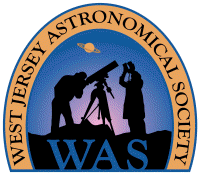| Weather Links |
Mercury 2023 |
Comet C/2022 E3 (ZTF) Brightens
December
30, 2022
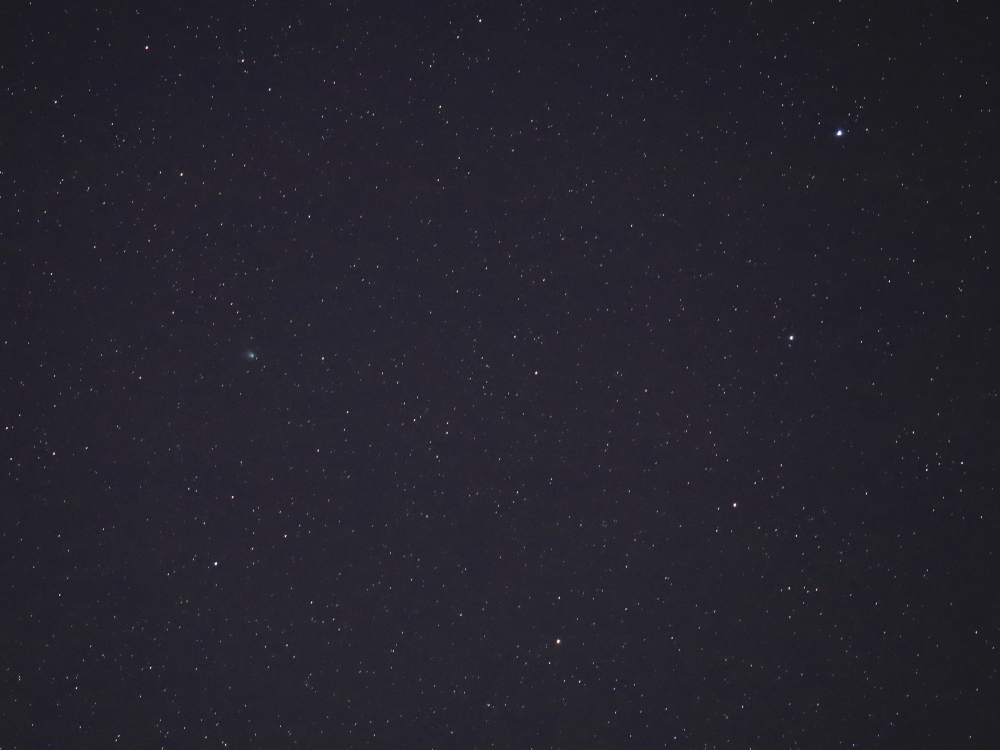
|
Comet
C/2022 E3 (ZTF)
was captured in this snapshot taken on
December 30, 2022,
at 5:47 am EST
from Atsion in Wharton State Forest, NJ, with a Canon EOS RP DSLM camera and a Canon 200 mm
f/2.8L telephoto lens on a fixed tripod. It's a single raw frame
exposed 4 seconds at f/2.8, ISO 10,000. The raw image was
slightly adjusted, cropped to about 90% of the original linear dimensions for a
4:3 aspect ratio and a field
8.6° wide x 6.4° high, then converted to a JPEG in
Canon's Digital Photo Professional 4.
Mouseover for labels.
On this morning, C/2022 E3
was in the constellation
Corona Borealis (here's a view with the
entire
semicircle) and was easily seen in a clear sky at 4:40 am with
handheld 15x56 binoculars.
Current visual estimates at COBS are running in the magnitude
7.x range as of Dec 30. |
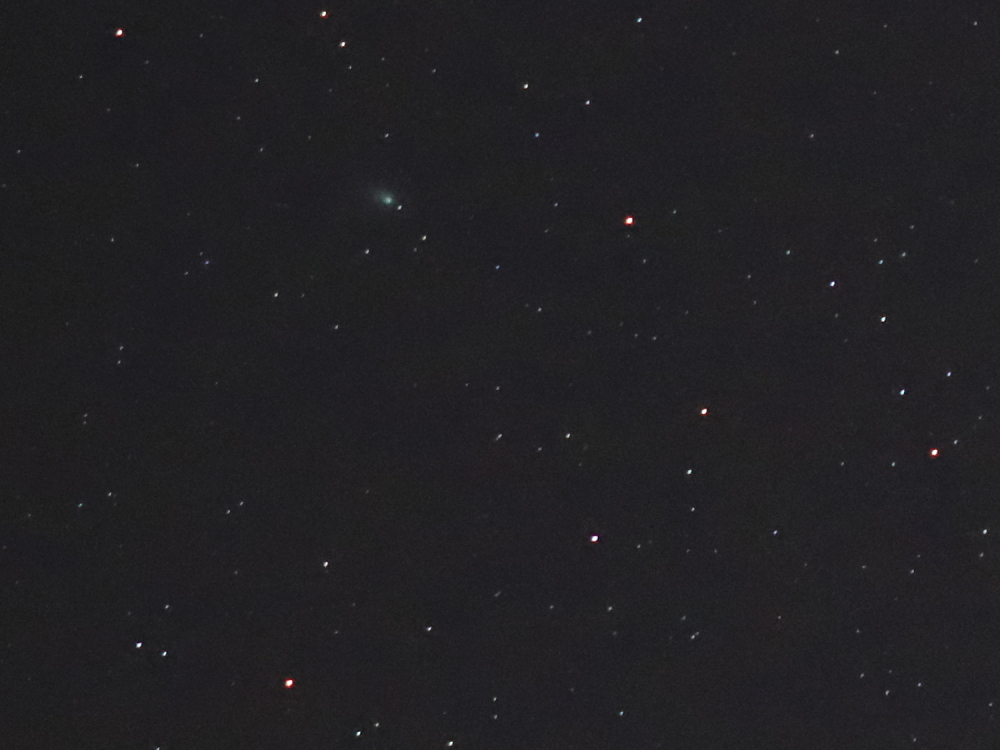
|
This snapshot of comet
C/2022 E3 (ZTF)
was also taken at Atsion on
December 30, 2022,
but at 5:05 am EST, with the same Canon EOS RP DSLM camera and a Canon 200 mm
f/2.8L telephoto lens on a fixed tripod. It's a single raw frame
exposed just 2 seconds at f/2.8, ISO 12,800 (the shorter
exposure allows a greater magnifying crop without star trailing
that would be seen at 4 seconds exposure). The enlargement
better shows the stubby dust tail to the upper-left of the coma
(the SkyTools finder chart linked near the top of this page
shows the ion tail, which is not visible here).
The raw image was
slightly adjusted, cropped to about 25%% of the original linear dimensions for a
4:3 aspect ratio and a field
2.5° wide x 1.9° high, then converted to a JPEG in
Canon's Digital Photo Professional 4.
Mouseover for labels. The position at which the comet was
seen two days earlier is also marked. It moved about
three-quarters of a degree during that interval. |
Crescent Moon, Mercury and Venus
December
24, 2022
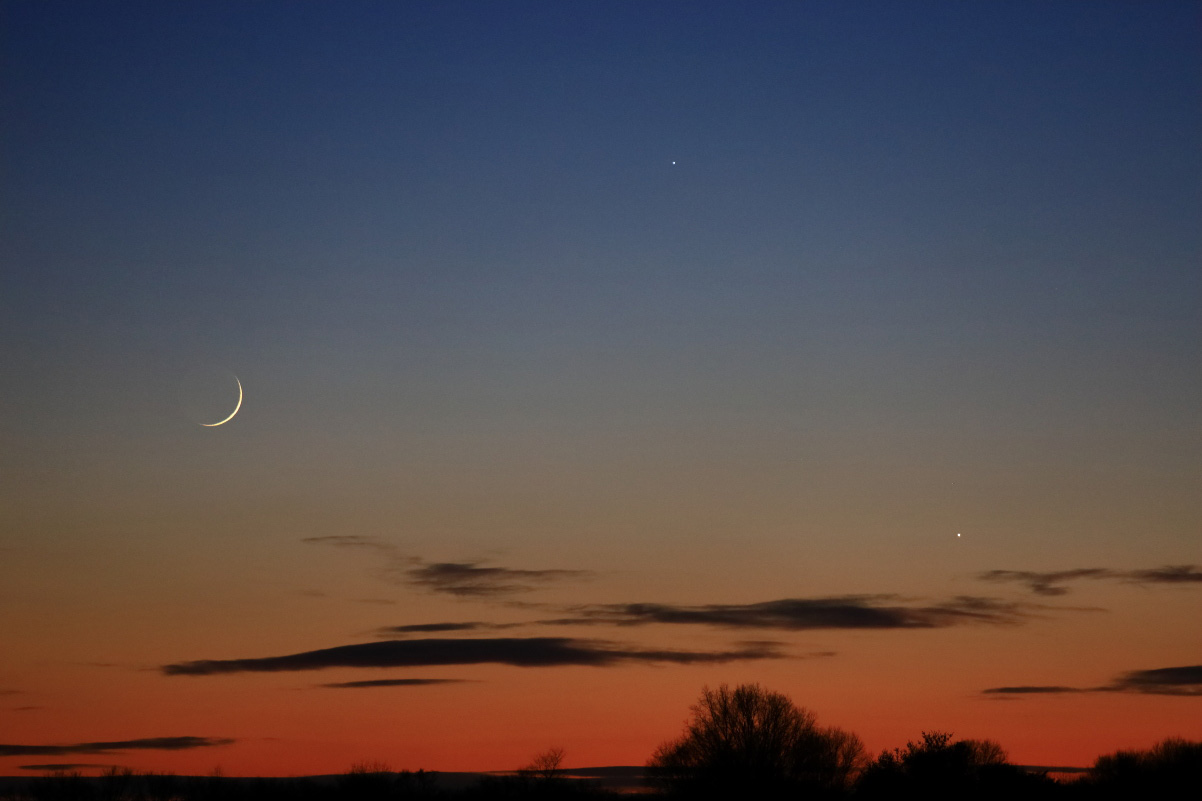
|
On Christmas Eve,
December 24, 2022, the 36.1 hr old, 3.4% illuminated crescent
Moon with
earthshine joined
the planets
Mercury and
Venus along
the southwest horizon after sunset. This snapshot of them was captured
at 5:23 pm EST, 43 minutes after sunset at 4:40 pm. Taken with a Canon EOS RP DSLM camera and a Canon 200 mm
f/2.8L telephoto lens on a fixed tripod. It's a single raw frame
exposed 1/60 second at f/2.8, ISO 1600, daylight white balance.
The raw image was mildly adjusted and saved to a JPEG with
Canon's Digital Photo Professional 4. It's uncropped for a field
10.3° wide x 6.9° high. At the time the picture was captured,
the Moon was at 4.7° altitude, 6.6° from Venus and 4.6° from
Mercury. Venus and Mercury
were 4.2° apart.
Mouseover for labels.
As discussed in this
Bob King article at Sky & Telescope online, during this
Mercury elongation, all of the solar system's planets could be
sighted in short order. This evening, I arrived at Swede Run at
5:00 pm and immediately saw the Moon and Venus with unaided
eyes. I then looked with 8x42 binoculars and saw Mercury along
with Venus and the Moon, simultaneously in the same 9.1°
field-of-view. By 5:05 pm, Mercury was unambiguous with unaided
eyes. It was at greatest eastern elongation on December 21, and on December 24, it was 49%
illuminated (technically a crescent). It had had dimmed slightly
from previous sightings this month to
magnitude -0.3.
At 5:15 pm, I looked up and the other two bright planets,
Jupiter and Mars, were obvious to unaided eyes. Dimmer Saturn
was also seen with a little effort. With the 8x42s as twilight
darkened, I spotted even dimmer Uranus at 5:25 pm, but I couldn't
find Neptune, the dimmest planet, at Swede Run. However, on the
way home I stopped at the vegetable stand on Church St in
Moorestown, where at 5:50 pm, I did find Neptune with the 8x42s.
That's the third time this week I've spotted all the planets in
less than an hour, previously on December 18 and 21. |
Comet C/2022 E3 (ZTF)
December
21, 2022
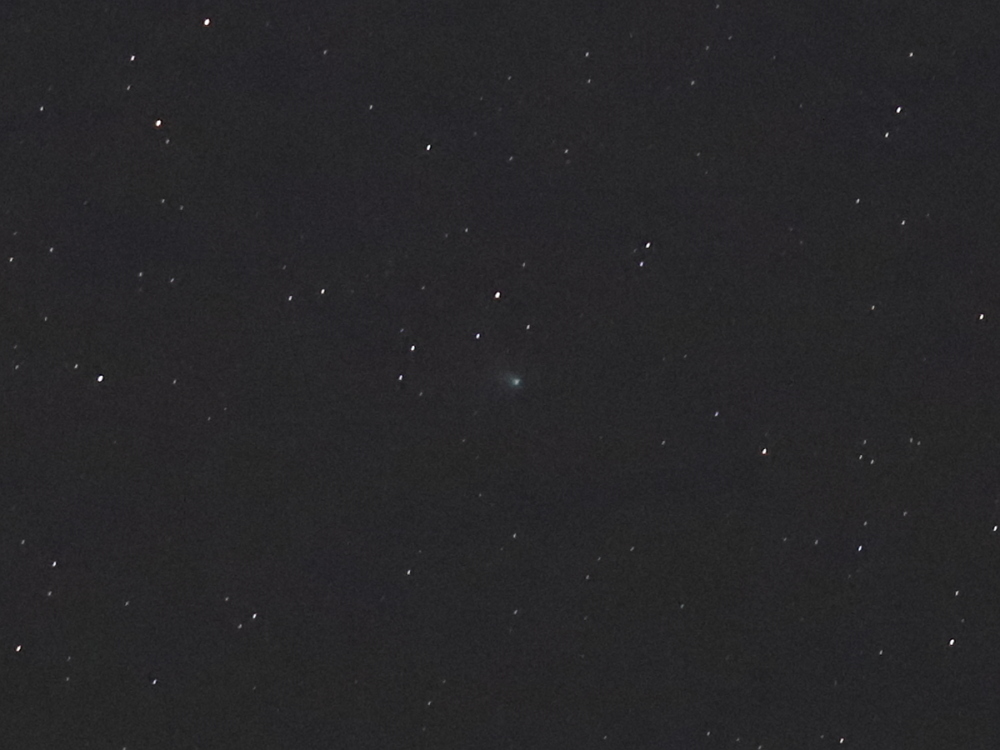
|
Comet
C/2022 E3 (ZTF)
was captured in this snapshot taken on
December 21, 2022,
at 4:50 am EST
from Wharton State Forest in NJ with a Canon EOS RP DSLM camera and a Canon 200 mm
f/2.8L telephoto lens on a fixed tripod. It's a single raw frame
exposed 2 seconds at f/2.8, ISO 12,800. The raw image was
slightly adjusted, cropped to about 20% of the original linear dimensions for a
4:3 aspect ratio and a field
2.0° wide x 1.5° high, then converted to a JPEG in
Canon's Digital Photo Professional 4.
Mouseover for a label.
On the morning of December 21, C/2022 E3
was in the constellation
Corona Borealis (near Epsilon CrB) and was easily found
initially at 4:37 am with a 115 mm spotting scope at 30x with
which it displayed the coma extension to the left as seen in the
image. Subsequently, it was seen as a faint smudge in 15x56
binoculars (the first time for me with binoculars after several
prior sightings with the 115 mm scope).
Current estimates at COBS are running around
magnitude 8, and by February 2023, it should reach magnitude 5
or so. |
Mercury and Venus
December
9, 2022
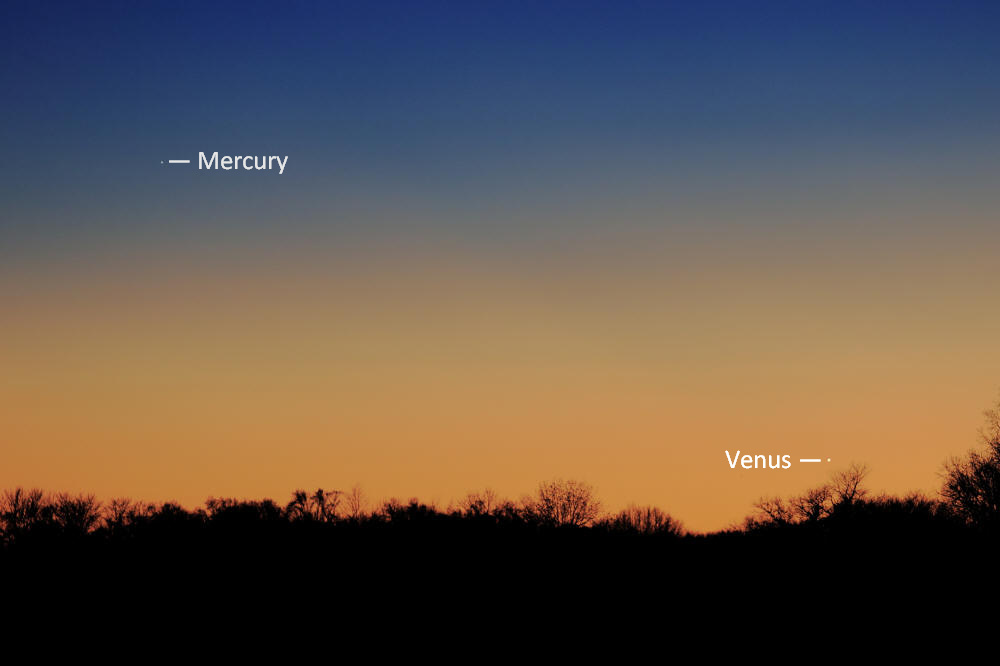
|
The planets
Mercury
and Venus were
captured in this snapshot taken at 5:08 pm EST on
December 9, 2022, from Swede Run in Moorestown,
NJ, where the sun set at 4:34 pm. Venus, magnitude -3.9, was initially spotted with 15x56
binoculars at 4:39 pm when it was at 6.0°
altitude. Mercury was initially spotted with the 15x56s at 4:55
pm when it was 5.6° altitude. I then had a solid sighting of
Venus (not just a glimpse) with unaided eyes at 4:57 pm when it
was at 3.3° altitude. This is my first such unaided-eye
sighting this elongation. At the time of the picture, the two
planets were 5.0° apart, while Mercury and Venus were 3.7° and
1.7° altitude respectively. Taken with a Canon EOS RP DSLM camera and a Canon
200
mm f/2.8L telephoto lens on a fixed tripod. It's a single raw
frame exposed 1/200 second at f/2.8, ISO 800. The raw image was mildly adjusted
and cropped to 64% of the original linear dimensions for a field
6.6° wide x 4.4° high, then converted to a JPEG in
Canon's Digital Photo Professional 4.
Mouseover to clear labels. |
The Moon Passes Close to Mars
December
7, 2022
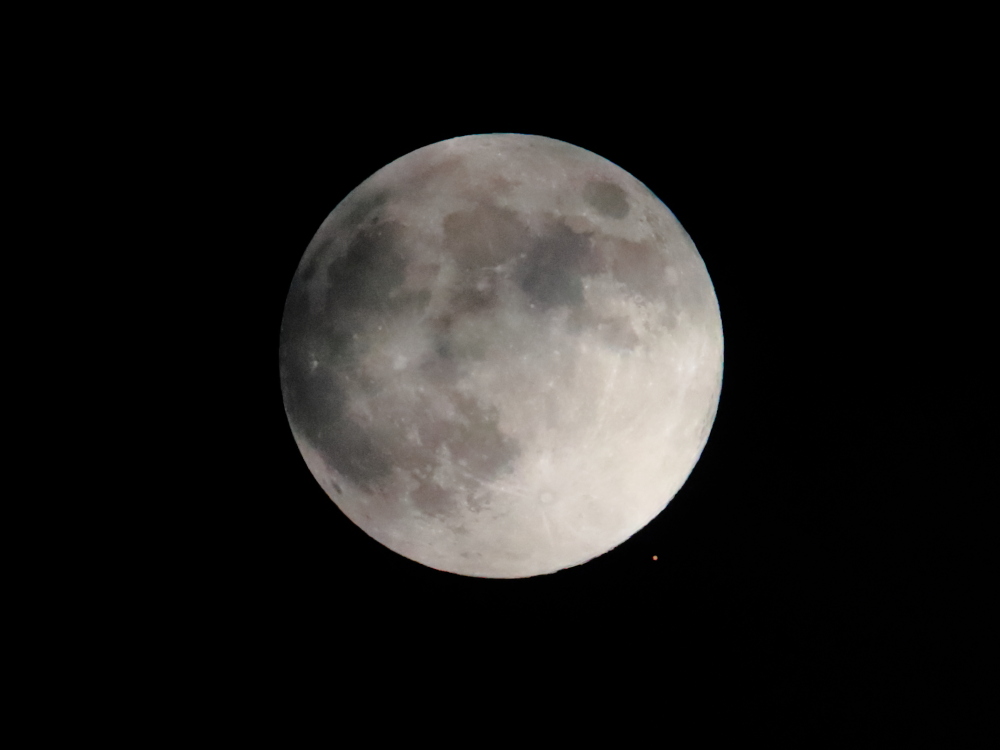
|
On
December 7, 2022, the Moon, full at 11:08 pm
EST, would occult the planet Mars, which would reach opposition
about one-and-a-half hours later, at 12:42 am on December 8, so
essentially,
both objects were at opposition. However, while
much of the United States would see an occultation (the Moon
passing in front of Mars), here in New Jersey, it would be a
near miss. At my home in Maple Shade, NJ, at the closest
approach around 10:50 pm, there would be less than an arc minute
of separation. Unfortunately, the gloomy weather during the day
continued into the night and at the time of closest approach, it
was mostly cloudy. However, there were fleeting gaps in the
cloud density exposing the Moon and Mars side-by-side through a
hazy veil.
Initially, I stepped out front at 10:50 pm
with little hope of seeing the moon. Quite luckily, it was
visible (in spurts) and I was able to see Mars close to the Moon with
15x56
binoculars. I then got out my camera and took some snapshots,
including the one above when Mars was 2'20" from the lunar limb. I was back out at 11:20 pm with my 88
mm apo spotting scope, and using the 25 to 60x range of the zoom
eyepiece, I had a very nice view of the pair during moments of
sufficient clearing. In particular, Mars showed a nice ruddy
disc, even at 25x. In the picture, the Moon would be moving
nominally from the upper right to the lower left (west to east)
with respect to the background stars and Mars.
The picture above was taken at 11:10 pm with a Canon EOS RP DSLM
camera and a Tamron 150 to 600 mm f/5.0-6.3 zoom lens (set to
600 mm focal length) on a fixed tripod. It was manually exposed 1/125 sec at
f/8.0, ISO 6400 and daylight white balance. It was difficult to get a
good exposure due to the fluctuations in brightness caused by
the passing clouds, which also reduced the sharpness a bit. It
was mildly adjusted in Canon's Digital Photo Professional 4 and
cropped to a 4:3 ratio using about a third of the
original frame
for a displayed field 1.10° wide x 0.83° high.
Mouseover for labels.
The image below is a further crop of the same snapshot above, to
about 9% of the original frame (and a 16:9 ratio) for a field
0.33° wide x 0.19° high to better show Mars. No additional
adjustments were made. |
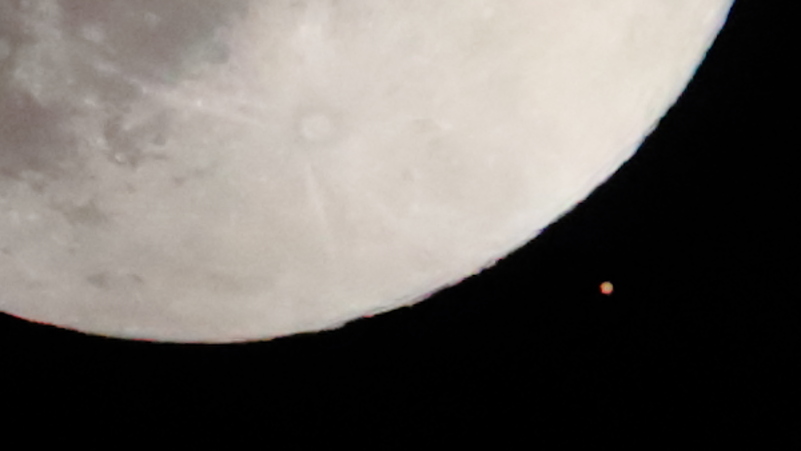
Click here
for the previous page.
Click here
for an index to all previous SJAstro pages.







